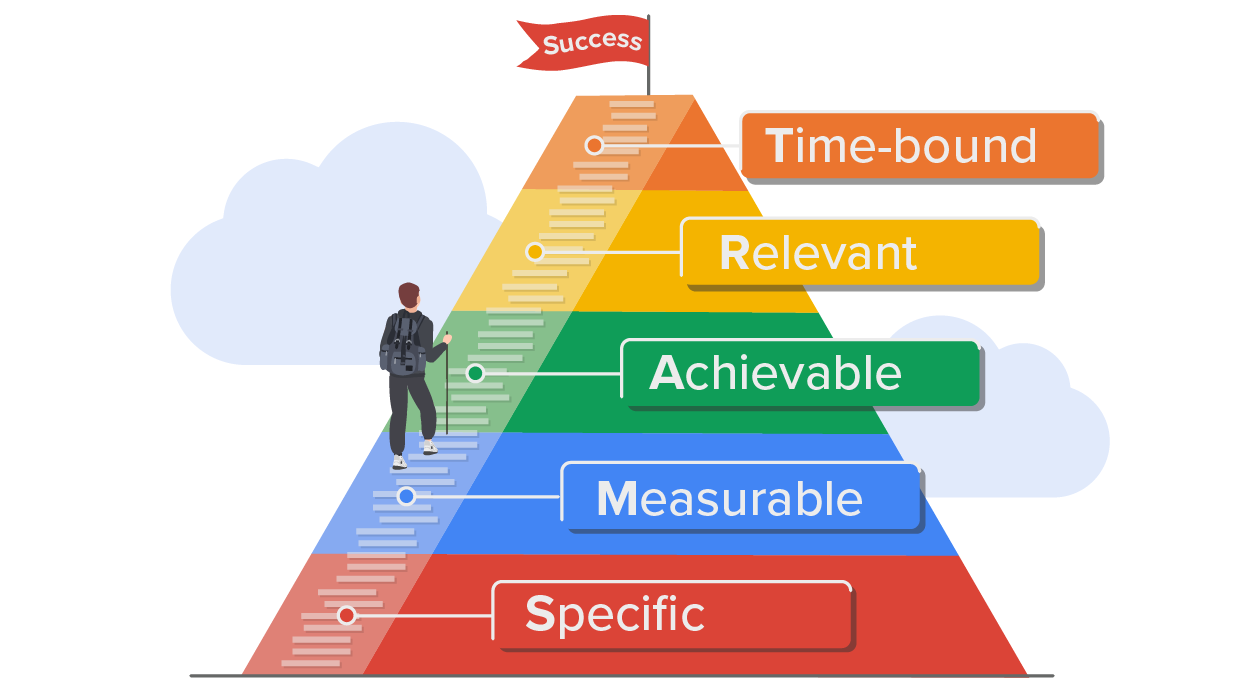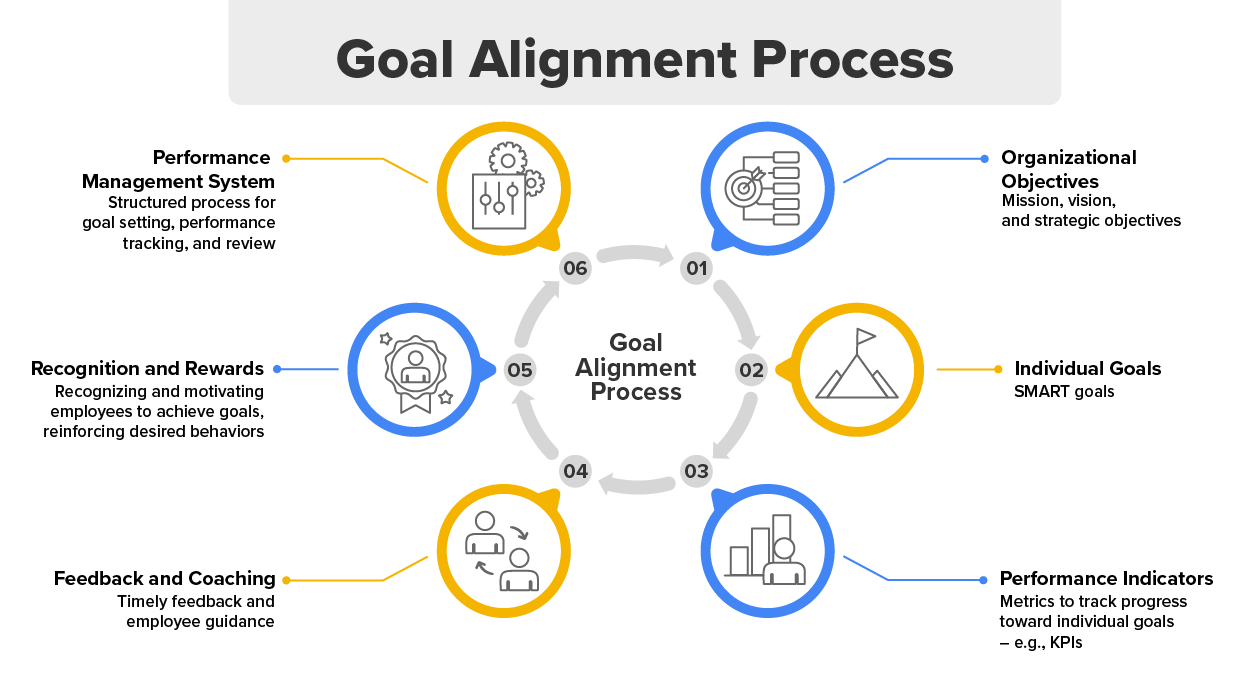Table of Contents |
Goal setting is a critical element in performance management, providing numerous benefits to both organizations and individuals. The table below outlines the importance of goals, detailing their descriptions and the specific impacts they have on organizations and individuals. By understanding these aspects, organizations can better implement effective goal-setting strategies to enhance overall performance and foster a productive work environment.
| Importance of Goals | Description | Impact on Organization | Impact on Individual |
|---|---|---|---|
| Provides direction and focus | Employees know what is expected and can concentrate their efforts on specific outcomes. | Aligns efforts with organizational objectives. | Increases clarity and purpose in daily tasks. |
| Helps prioritize tasks and manage time | Clear goals enable effective task prioritization and time management. | Enhances overall efficiency and productivity. | Reduces stress and improves time management skills. |
| Increases productivity and motivation | Without clear goals, employees might feel lost, leading to decreased productivity and motivation. | Boosts organizational performance and output. | Enhances motivation and job satisfaction. |
| Enables measurement of success | Goals provide benchmarks for evaluating performance and tracking progress. | Facilitates strategic planning and resource allocation. | Provides a clear sense of achievement and progress. |
| Facilitates objective performance assessments | Measurable goals make it easier to identify strengths and areas for improvement. | Improves performance management processes. | Offers constructive feedback and growth opportunities. |
| Supports rewarding achievements and addressing issues | Goals provide a basis for recognizing accomplishments and addressing performance problems. | Encourages a culture of recognition and accountability. | Increases morale and motivation through recognition. |
| Fosters accountability | Specific targets encourage employees to take ownership of their work. | Enhances responsibility and ownership within the team. | Builds a sense of responsibility and commitment. |
| Enhances engagement and commitment | Accountability leads to higher levels of engagement and commitment. | Strengthens employee loyalty and retention. | Increases personal investment in work outcomes. |
| Reduces ambiguity and confusion | Clear goals minimize stress and dissatisfaction by reducing uncertainty. | Creates a more stable and predictable work environment. | Reduces stress and increases job satisfaction. |
Effective goals are often described using the SMART criteria. The acronym SMART stands for: Specific, Measurable, Achievable, Relevant, and Time-bound.

Specific goals clearly define what is to be accomplished, leaving no room for ambiguity. Specificity helps employees understand exactly what is expected of them and how they can achieve it.
EXAMPLE
Instead of setting a vague goal like “improve sales,” a manager could set a specific goal like “increase sales by 10% in the next quarter.” This clarity helps employees focus their efforts on concrete actions that will lead to the desired outcome.Measurable goals include criteria that allow for tracking progress and determining when the goal has been met. This measurability is essential for providing feedback and recognizing accomplishments.
EXAMPLE
A measurable goal might involve tracking the number of new clients acquired or the percentage increase in customer satisfaction scores. By having clear metrics, employees and managers can objectively assess performance and make data-driven decisions.Achievable goals are realistic and attainable given the resources and constraints. Setting goals that are too difficult can be demotivating, while goals that are too easy may not provide enough challenge to drive performance. Achievable goals strike a balance between being challenging and realistic.
EXAMPLE
A manager setting a goal to “complete a project within six months using the current team and budget” is more achievable than an overly ambitious goal that doesn’t consider existing limitations.Relevant goals align with broader organizational objectives and are meaningful to the employee’s role. This relevance ensures that the goals contribute to the overall success of the organization.
EXAMPLE
A relevant goal for a marketing team might be to “launch a new social media campaign to increase brand awareness,” which directly supports the company’s marketing strategy. When employees see how their goals align with the organization’s mission, they are more likely to be motivated and committed to achieving them.Time-bound goals have a clear deadline or timeframe for completion. This time constraint creates a sense of urgency and helps employees stay focused on their tasks.
EXAMPLE
Setting a goal to “submit the quarterly report by the end of the month” provides a specific timeframe for completion. Time-bound goals help prevent procrastination and ensure that tasks are completed in a timely manner.IN CONTEXT
An HR manager sets a goal for the recruitment team. The goal is to “hire 15 new software engineers within the next three months to support the upcoming project launch.”
This goal is:This SMART goal helps the recruitment team focus their efforts, track their progress, and contribute to the company’s success.
- Specific: Clearly defines the number of hires and the role.
- Measurable: Progress can be tracked by the number of hires.
- Achievable: Based on the team’s capacity and market conditions.
- Relevant: Aligns with the company’s need for talent for a critical project.
- Time-bound: Has a clear deadline of three months.
Setting and reviewing goals is a process that supports both employee growth and organizational achievements. It involves managers and employees working together to create clear and achievable objectives that align with the organization’s broader aims. Regular check-ins and adjustments help maintain progress and address any challenges that arise. Continuous feedback and support from managers keep employees motivated and engaged, leading to higher productivity and success.
| Phase | Description |
|---|---|
| Initial Goal Setting | Managers and employees collaborate to set clear, achievable goals aligned with the employee’s role and the organization’s objectives. This phase involves discussing the employee’s strengths, areas for improvement, and career aspirations to set challenging yet attainable goals. |
| Regular Reviews | Regular reviews are conducted at intervals (e.g., quarterly or semi-annually) to assess progress, address challenges, and make necessary adjustments to goals or strategies. These reviews help keep employees motivated and engaged by providing continuous feedback and recognizing achievements. |
| Collaborative Problem-Solving | During regular reviews, managers and employees discuss obstacles hindering progress and develop strategies to overcome them. This approach helps employees feel supported and valued, boosting morale and motivation. Reviews also provide opportunities to celebrate successes and recognize hard work and achievements. |
| Adjusting Goals | Goals are adjusted as needed to remain relevant and achievable in response to changing circumstances, such as new responsibilities or shifts in organizational priorities. This flexibility ensures that goals continue to drive performance and support overall objectives. |
| Ongoing Feedback and Support | Managers provide regular feedback and support to help employees stay motivated and on track to achieve their goals. This collaborative and flexible approach leads to higher levels of engagement, productivity, and overall success. |
Goal setting aligns individual performance with organizational objectives through strategic alignment and performance tracking. Strategic alignment ensures that individual goals support the broader goals of the organization. When employees understand how their work contributes to the organization’s success, they are more likely to be motivated and committed to achieving their goals. This alignment creates a sense of purpose and helps employees see the bigger picture.
Performance tracking involves monitoring progress toward goals and making adjustments as needed. Regular tracking allows managers to identify areas where employees are excelling and where improvement is needed, enabling timely feedback and interventions. This helps keep employees on course to achieve their goals and ensures any issues are addressed promptly. Performance tracking also creates opportunities for recognizing and rewarding achievements, which motivates employees and reinforces positive behaviors. Additionally, the data collected can inform future goal setting and improve performance management practices.
Strategic alignment involves ensuring that individual goals are directly linked to the organization’s mission, vision, and strategic objectives. This alignment helps create a cohesive and focused workforce where everyone is working towards common goals.
EXAMPLE
If an organization’s strategic objective is to expand into new markets, individual goals for the sales team might include targets for acquiring new clients in those markets. By aligning individual goals with organizational objectives, employees can see how their efforts contribute to the overall success of the organization.Goal setting aligns individual performance with organizational objectives through strategic alignment and performance tracking. By ensuring that individual goals align with the broader goals of the organization, employees can see how their work contributes to the organization’s success. Regular performance tracking helps ensure that goals are being met and provides a basis for recognizing and rewarding achievements. This alignment and tracking process helps create a motivated and focused workforce that is better equipped to achieve its objectives.

Source: This Tutorial has been adapted from "Human Resources Management" by Lumen Learning. Access for free at courses.lumenlearning.com/wm-humanresourcesmgmt/. License: CC BY: Attribution.